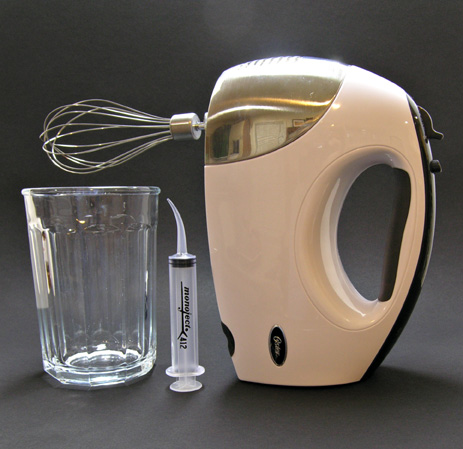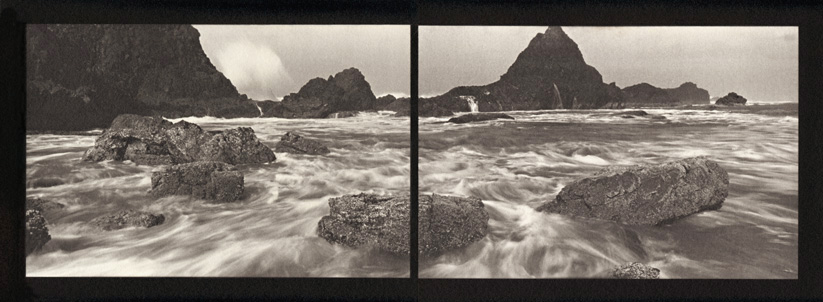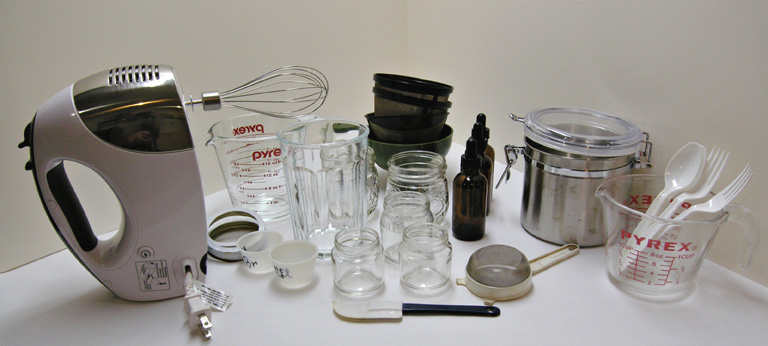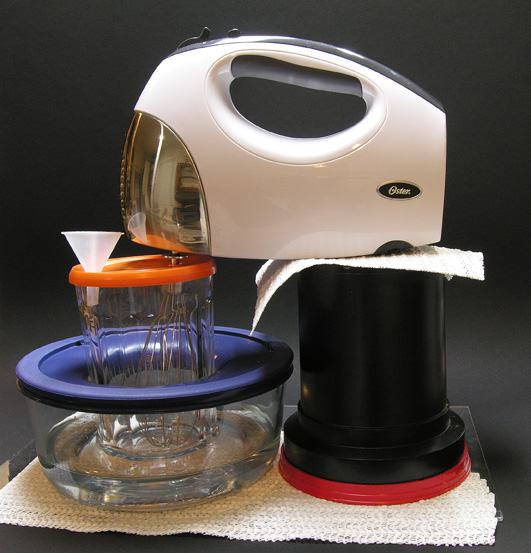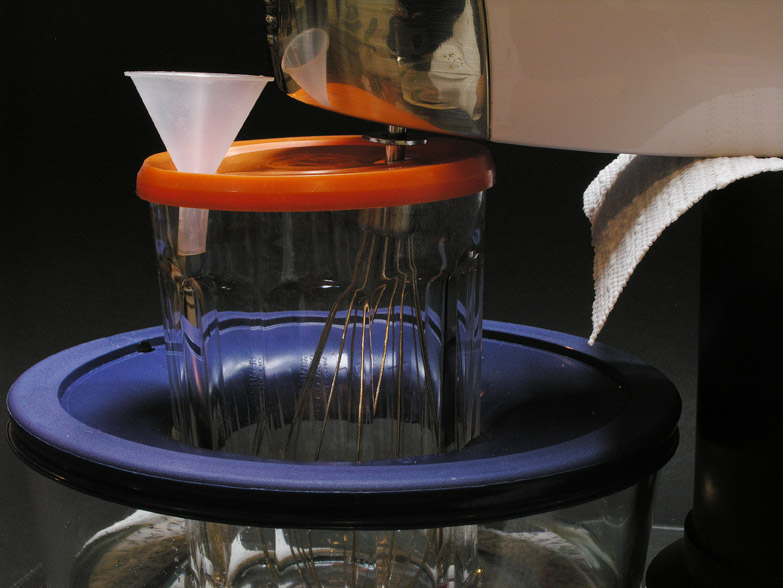|
Dissolve NaCl set at room temp.
Dissolve AgNO3 warm to 40°C. (Tip: at no time
let silver nitrate touch your skin.)
Dissolve 0.5 g citric acid in 10 ml water warm to 40°C.
- Set the working glass in a 55°C waterbath.
- Strain melted Gel A through a tea strainer into the glass.
- Add in this order, stirring briskly with a plastic spoon after each addition:
NH4Br, 0.5 g dry citric acid, and the NaCl solution.
- Combine the warm citric acid solution and the AgNO3 solution.
Suck up about 10 ml into a syringe. Hold the rest at 40°C.
- Pull the waterbath off its heat source and place it in a stable
surface with a piece of slipstop fabric under it to hold it in place
during the mixing procedure. Put the whisk neck through the 5/8"
hole and a small funnel in the small hole.
- GO TO SAFELIGHT
- Touch the tip of the syringe to a clean paper towel and carefully
shove the tip into the neck of the funnel in the lid of the working
glass
(being careful to not depress the plunger).
- Turn on the mixer at slowest speed and immediately start to slowly
and evenly add the silver solution. (Aim for about a 1 ml/second emptying
rate.) This is termed the Precipitation or Emulsification
step.
- As quickly as possible, repeat the process (either by refilling the
first syringe, or using a pre-filled second. There will probably
be a little silver solution still left. If so, repeat a third time
with whatever is left. (It is important to use every drop of solution.)
- Continue mixing for about 10 seconds after the last of the silver
solution has been added.
- Remove the lid and whisk. Place the waterbath with the glass
of emulsion back on its heat source.
- Check the waterbath temperature to make sure it's still at 52-53°C.
Adjust if necessary. (Have both very hot water and very cold water
standing by to make adjustments.)
- Spritz the surface of the emulsion with Everclear and gently stir
the emulsion for three minutes with a plastic spoon. (Check the
waterbath temperature to make sure it's still at 52-53°C.)
- Fluff the bloomed Gel B with the tines of a plastic fork. Switch to a plastic spoon, and over 2 minutes time incorporate B
into the emulsion (i.e. add it to the emulsion with stirring, including
stirring up from the bottom). When it has all been added, stir an
additional minute for 3 minutes total. (Tip: Total times, in the
heat and out, are emulsion variables. They are not hard and fast rules,
but do take notes if your procedure varies so that you can calibrate
cause and effect between makes.)
- Divide the emulsion between two canning jars. (Pour through a
stainless steel tea strainer. The mixture will be frothy. You
may need to press the emulsion through the strainer with a scraper.
Try to divide the emulsion evenly. Place a double layer of plastic
wrap over the top of each jar and secure with the lid ring. (Tip: You
don't want to use the metal lids that comes with the jar. They will
react unfavorably with the emulsion.)
- Immediately refrigerate in lightproof canisters pre-chilled with a
half inch of cold water. (Tip: Every household goods store I've been in
sells a version of stainless canister with a snap-down plastic lid.
Place several layers of black plastic — cut up trash bags — between the
canister and the lid.)
ADDING FINALS BEFORE COATING
Preheat crockpot waterbath to
50-52°C.
Preheat a waterbath on the hot plate to 43°C.
Have ready:
- Dropper bottle of 1% Potassium iodide (KI). (To make: Mix 1g KI with
100g hot water)
- Dropper bottle of Photoflo 600.
- Dropper bottle of glyoxal.
- Coating tools and surfaces.
- Precut paper and small pieces of adhesive tape (I tear off about 36
1-inch pieces and line them up on the clothesline over my sink.)
- Small jar of Everclear.
- Strainers (tea and gold mesh coffee filters) and plastic canning
funnel.
- Hot distilled water.
- Wash buckets (one with hot soapy water, one with hot clean water).
- A second cafe glass (or quart canning jar) sitting in a quart-size
glass measuring cup or dish, with room temperature water as high as
possible before the cafe glass is unstable.
GO TO SAFELIGHT
Melt one jar (1/2 batch) of emulsion: Remove jar from the lightproof
container and place in a 40°C waterbath (have the water level at about the
height of the top of the emulsion). Stick a thermometer through the
plastic wrap into the emulsion. When the temperature of the emulsion
hits about 38°C, remove the plastic wrap and gently stir with a clean
plastic spoon until the emulsion is 41-42°C.
Strain the melted emulsion through a stainless steel tea strainer into
the cafe glass in the crockpot. Keep the waterbath temperature at
49-51°C. While constantly stirring with a plastic spoon, add 15 drops 1% KI solution at about a drop per second, stir
one minute. In the same manner, add 12 drops Photoflo 600, stir one minute. Add 15
drops glyoxal and then spritz the surface of the emulsion with Everclear.
Remove the glass from the waterbath and wipe the outside dry. Pour
into the second cafe glass through a stack of two or three gold mesh
coffee filters. Spritz with Everclear. Set the water-jacketed
emulsion on the hot plate.
Begin coating. (More about
coating here.) (Tip: The waterjacket should warm up at
close to the same rate as the emulsion cools. This keeps the
emulsion at about the same temperature during coating. A little experience with your
workflow will quickly help you determine your temperature parameters.)
The first coating pass with tell you two things:
1) Is the emulsion cool enough? If the coating is too warm it
will go on too thin and you'll be able to see the dull paper through the
shiny emulsion. Just wait a couple of minutes, give the emulsion a
gentle stir with a clean plastic spoon, and try again. Mark this
first sheet because it's not wasted. It can be cut into test
strips when you start printing.
2) Is the surfactant right? If you see air bubbles or spots
(repellency indicators) add another drop of Photoflo 600 and give a
gentle stir.
A few more tips:
- Tiny bubbles, often in a cluster, indicate that you probably added
air during the emulsion take-up. Have an atomizer bottle of Everclear
close at hand and immediately spritz the bubble patch from about 4
inches. The bubbles should disappear. If they remain, don't
try again. After the emulsion starts to set, Everclear can leave
its own marks on the surface. Make note of the location of the
defect and avoid printing on that area.
- Keep a black permanent marker close at hand. Right after
coating, the surface of the emulsion is shiny and any and all defects
are plainly visible. It is a simple matter to make a map along the
uncoated edge of the paper to guide your printing.
- After the paper is dry, and you start to stack the sheets for
storage in a paper safe (or light proof bag) triage the sheets.
Start with the 'ugly' ones on top. These will be your test strips
and you'll soon value them. They eliminate the stress of cutting
up perfect sheets for testing ;-)
- One defect that doesn't show up until printing is "slugs". If
you see them, you'll recognize them. Good straining all but
eliminates the problem.
|
